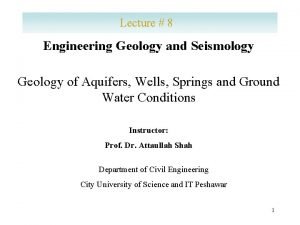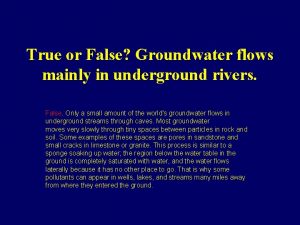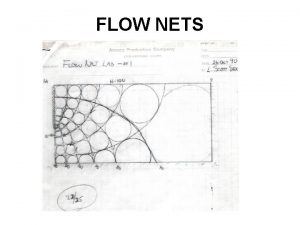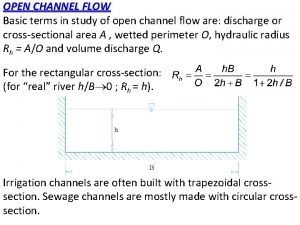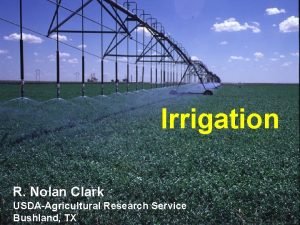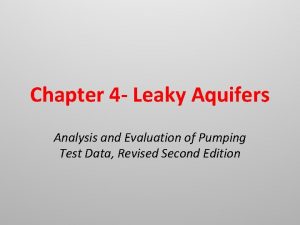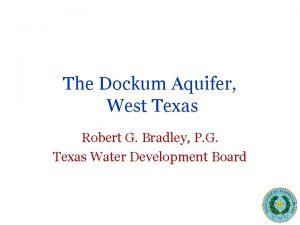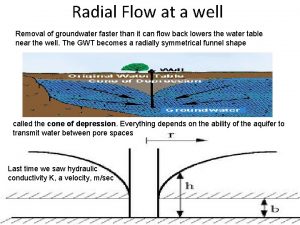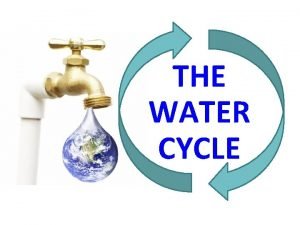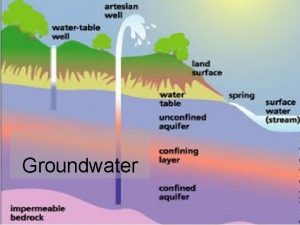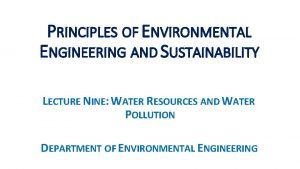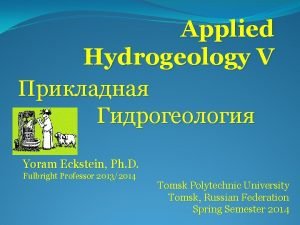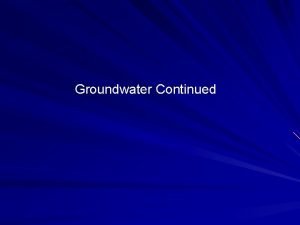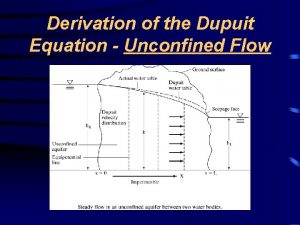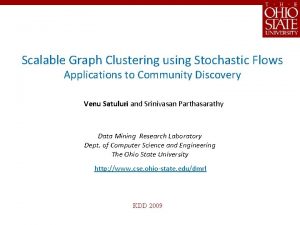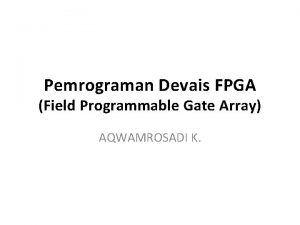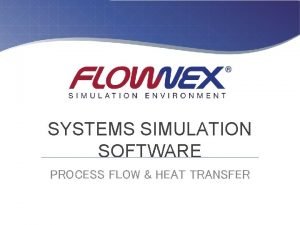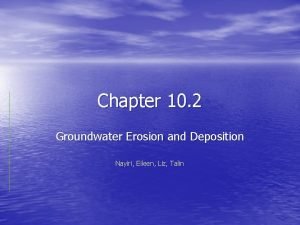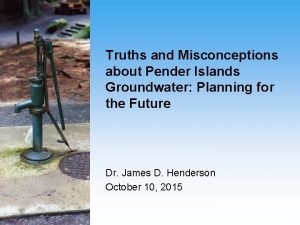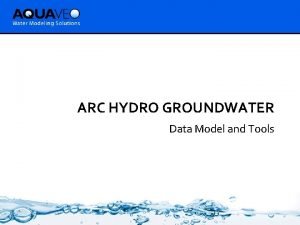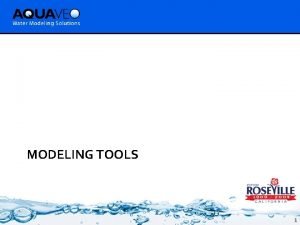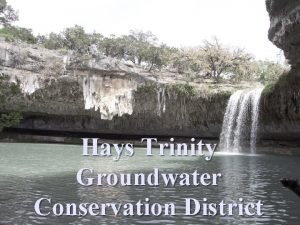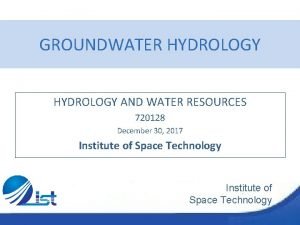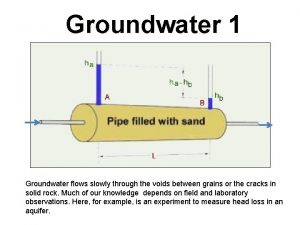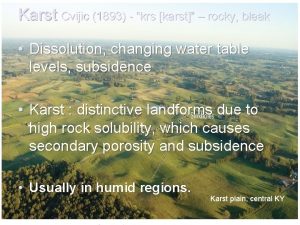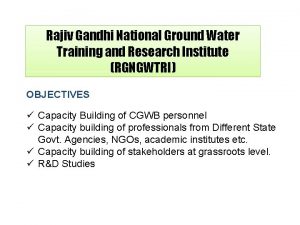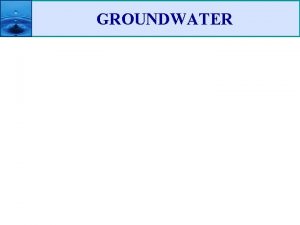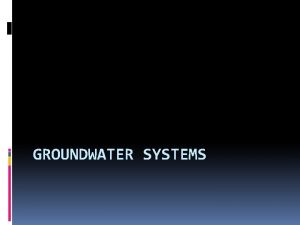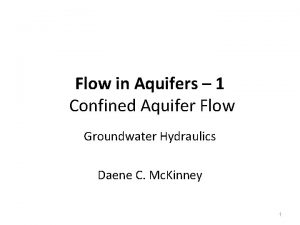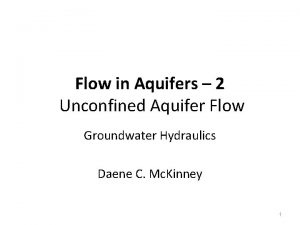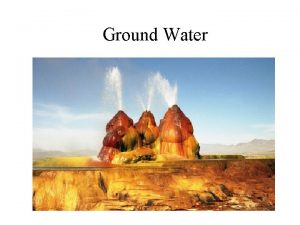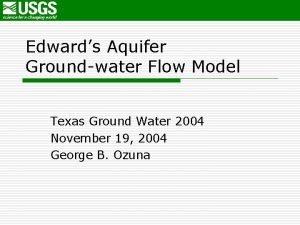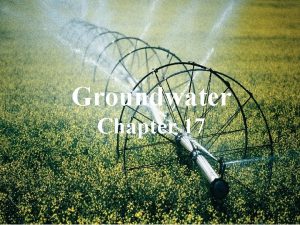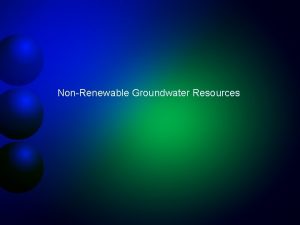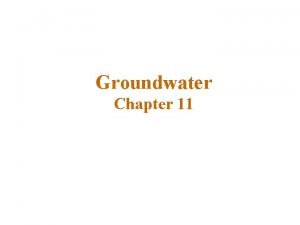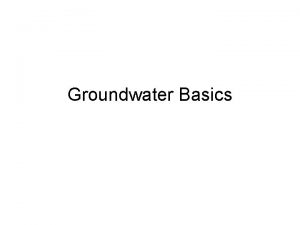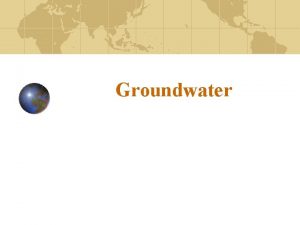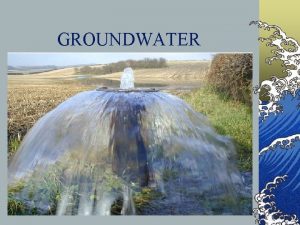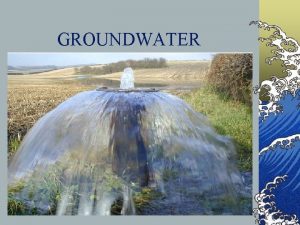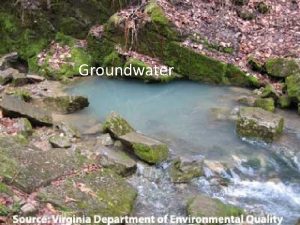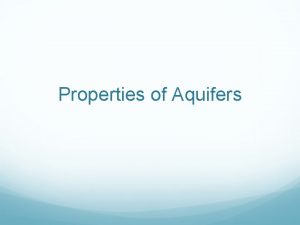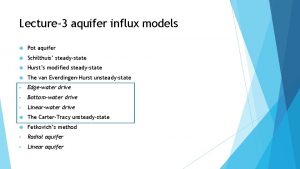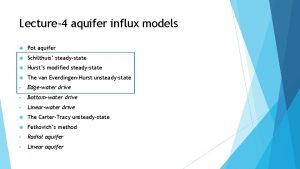SIMULATION OF GROUNDWATER FLOW IN THE ERIN AQUIFER





























- Slides: 29

SIMULATION OF GROUNDWATER FLOW IN THE ERIN AQUIFER Objective: conceptual model definition and steady state simulation of groundwater flow

Coastal Aquifer Management in the Caribbean-II Groundwater modelling Purpose of modelling!!!!

Coastal Aquifer Management in the Caribbean-II Conceptual model: a numerical model may constitute a good ‘real system’ representation if it is based in a solid conceptual model (built with available data and scientific knowledge) Physical aspects -Aquifer type : water table, confined, multilayer…. . -Porous/fracutered media -flow regime: steady-state, transient. -Geometry -Boundary conditions: impervious, flow… -Change of properties: homogeneous, … Actions -Natural: recharge, discharge -Artificial: pumping. Relevant processes -Flow: recharge, discharge -transport: pumping. Data provided by a classical hydrogeologic study (site specific) Numerical model structure (code selection)

Coastal Aquifer Management in the Caribbean-II Spatial discretisation of domain Network definition Parameters: K, S Geology, recharge Pumping wells

Coastal Aquifer Management in the Caribbean-II Time discretisation Dimension: 1 D, 2 D, 3 D Pumping, Climate, River stages, lateral inflows, etc

Outputs Piezometric level


ERIN AQUIFER- conceptual model Purpose: Aquifer(s) definition, parameters, geometry, gw level, etc… For a: GW flow numerical model definition (Visual MODFLOW 2009. 1 Pro)

AQUIFER: Geometry Aquifer geometry and hydrostratigraphic units characteristion is obtained through: -geological methods (geologic logs) -geochemical methods (hydrochemistry) -geophysical methods (resistivity, logs…) - field surveys

AQUIFER: Geometry

AQUIFER: Geometry (II)

AQUIFER: Hydrostratigraphic aquifer Units

-D: detritic (unconfined) Semiconfined layers FC-124: sandy layer (190 m thickness) FC-200: sandy layer (135 m thickness) (hydraulically connected by the existing faults, lateral facies changes and also at the NE of the study area) Parameters Quatitative hydraulic parameters have not been obtained. (No pumping tests available). Average estimates of Hydraulic conductivity(K) for the Erin Sands range from 0. 5 – 12 m/day (ETI)

Piezometric level Water level observations and production wells abstraction data are integrated values for the great majority of the wells, as wells casing have been screened in all productive areas encountered along drilled depths. Aquifer recharge Visual-Balan, distributed model Aquifer recharge: 140 -290 mm/yr

AQUIFER: Conceptual model

NUMERICAL FLOW MODEL

NUMERICAL FLOW MODEL Visual MODFLOW. PRO 500 x 500 m grid size Study area model grid and boundary conditions. L. Candela, K. Tamoh, J. Jimenez-Martínez, F. J. Elorza. Technical University of Catalonia (Spain) R. Ramdin, R. Sankar, J. Francis, M. Julien, N. Mc Intosh, C. Santana. Water Authority and Sanitation-(WASA) S. D’Angelo. UNESCO-IHP

NUMERICAL FLOW MODEL The five defined layers of the Erin aquifer numerical model

NUMERICAL FLOW MODEL cross-section of the Erin aquifer numerical model Tridimensional shape of the modeled area

NUMERICAL FLOW MODEL Location of abstraction wells

RESULTS Calibration plot

RESULTS Conductivity (m/s) Specific yield 2. 05 E-5 0. 18 Layer 2 1. E-9 0. 05 Layer 3 (FC 124) 1. 3 E-5 0. 21 Layer 4 1. E-9 0. 05 Layer 5 (FW 200) 1. 1 E-5 0. 21 Layer 1 ( Detritic) final calibrated values of hydraulic parameters for the Erin hydrostratigraphic units

RESULTS Layer 1, Detritic. Head potential

RESULTS Layer 3, FC 124. head potential

RESULTS Layer 5, FC 200. head potential

RESULTS Simulated water balance

SENSITIVITY ANALYSIS : Effects of hydraulic conductivity In sea Out sea 8. 00 E+05 1. 28 E+08 6. 00 E+05 1. 28 E+08 4. 00 E+05 1. 28 E+08 2. 00 E+05 0. 00 E+00 -50% 1. 28 E+08 0% 50% Head Detritic 0% Head FW 200 40 20 10 0 0% 50% -50% Head FC 124 5 4 3 2 1 0 30 -50% 15 10 5 0 0% 50% -50% 0% 50%

SENSITIVITY ANALYSIS : Effects of recharge In sea Out sea 1. 50 E+06 2. 00 E+08 1. 50 E+08 1. 00 E+06 1. 00 E+08 5. 00 E+05 5. 00 E+07 0. 00 E+00 -20% 0% -40% 20% 40% Head Detritic -40% Head FW 200 30 10 8 6 4 2 0 2 1 0 0% 20% 40% 0 -40% -20% 40% Head FC 124 3 10 -20% 4 20 -40% 0. 00 E+00 -20% 0% 0% 20% 40% -20% 0% 20% 40%

CONCLUDING REMARKS: § Geologic characterisation of the unit proved to be non-sufficient to properly define the aquifer system conceptual model § Recharge is the most important parameter conditioning groundwater level § 20% decrease of natural recharge from precipitation could imply : 1) a decrease of groundwater level between 0. 7 and 4. 3 m 2) seawater input may increase into the aquifer up to 120 % 1 363 000 m 3 § An accurate DEM is needed for model definition § Results are only representative for steady state conditions and for the calibration period § Piezometric data acquisition along time (hydrographs) and specific aquifer water level is needed for future transient simulations. § Meteorological data for climate change impacts simulation under selected scenarios have not been provided and future impacts cannot be simulated.
 Confined aquifer vs unconfined aquifer
Confined aquifer vs unconfined aquifer Most groundwater comes from rain true or false
Most groundwater comes from rain true or false Groundwater flow net
Groundwater flow net Groundwater flow definition
Groundwater flow definition Ogallala aquifer
Ogallala aquifer Edible aquifer lab activity answers
Edible aquifer lab activity answers Leaky aquifer
Leaky aquifer Ogallala aquifer
Ogallala aquifer Dockum aquifer
Dockum aquifer Unconfined aquifer example problems
Unconfined aquifer example problems Water cycle pictures
Water cycle pictures Gulf coast aquifer
Gulf coast aquifer Ogallala aquifer
Ogallala aquifer Aquifer lsuhsc
Aquifer lsuhsc The floridan aquifer is consolidated.
The floridan aquifer is consolidated. Dupits equation for unconfined aquifer
Dupits equation for unconfined aquifer Graclus
Graclus Apakah tujuan dari functional simulation dalam design flow
Apakah tujuan dari functional simulation dalam design flow Flownex simulation software
Flownex simulation software Groundwater erosion and deposition
Groundwater erosion and deposition Zone of areation
Zone of areation Groundwater
Groundwater Groundwater
Groundwater Arc hydro groundwater
Arc hydro groundwater Gms groundwater modeling
Gms groundwater modeling Htgcd
Htgcd Groundwater
Groundwater Seepage velocity formula
Seepage velocity formula Karst topography
Karst topography Rajiv gandhi groundwater raipur
Rajiv gandhi groundwater raipur
